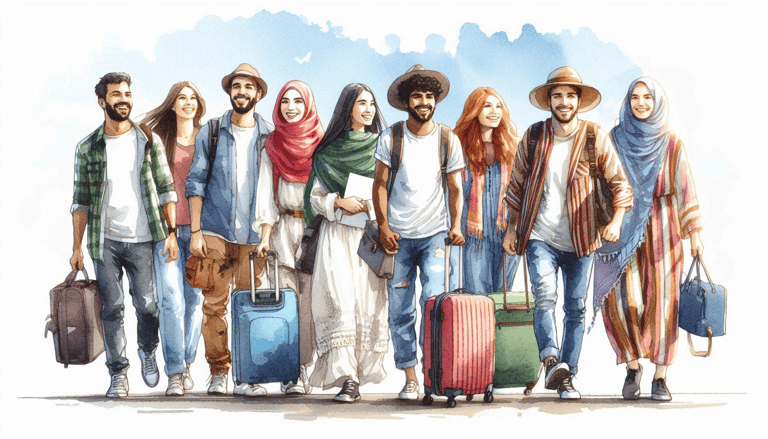Migration Crisis in Europe
Namrata Singh
Dr. D.Y. Patil College Of Law, Nerul
This blog is written by Namrata Singh, a Third-year law student of Dr. D.Y. Patil College Of Law, Nerul


INTRODUCTION
Earth is forever evolving, and over time, humans have learned to create boundaries in the inner and outer worlds. The creation of these limitations has helped us to maintain peace and security. Whenever someone tries to trespass, we take this as a threat to our present, future, as well as to our past heritage. But what if someone doesn’t have anywhere to go except your doors to knock, what if someone wants to find a living, some peace, and security under your shelter which was snatched from them on their own? But their struggle doesn’t end there because they don’t belong there and where they belong, were never honored.
But this is only one side of the story, as we all have learned to put national interest and integrity before ours. How can we trust a migrant that they will not hamper our peace and security? How can we hope a newcomer to understand our culture and to follow our traditions because as a human we tend to believe that our religion, culture, and traditions are superior to others? We tend to force our beliefs on others. It might not hamper our stability in the short term but we’ll have a greater impact in the future as the no. of migrants will keep on increasing in the future if they are not stopped by the state. And a state’s heritage will forever be lost. Even if we tackle all the above problems, migrants' education, healthcare, livelihood, and employment, why that be the government’s responsibility?
BACKGROUND
Migration has always been a major problem in Europe and it deeply affects the continent in social, political, and economic forums. Different challenges faced by Europe are demographic crisis, irregular migration, and the rehabilitation of asylum seekers (1)
According to the most recent data on international migrant stocks from 2020, Europe was home to nearly 87 million international migrants, marking a 16 percent increase since 2015, when around 75 million international migrants lived in the region. Of these migrants, over half—approximately 44 million—were Europeans who had relocated within the region, up from 38 million in 2015. Additionally, by 2020, the number of non-European migrants residing in Europe surpassed 40 million.
In 1990, the number of Europeans living abroad was comparable to the number of non-Europeans residing in Europe. However, while the influx of migrants into Europe has grown significantly, the number of Europeans living outside the continent largely decreased over the past 30 years, only recently reaching the levels seen in 1990. By 2020, around 19 million Europeans were living outside Europe, with the majority residing in Asia and North America. There was also a modest increase in the number of European migrants in Asia and Oceania between 2010 and 2020, as illustrated in the accompanying figure. (2)
UNFOLDING ISSUES
The battle for earning a livelihood, peace, and security comes with major problems making them one of the most chaotic processes in history. Even if a country gives shelter to the migrants, the overcrowded and inadequate housing makes the living conditions unhabitable. It strains the resources of the country, resulting in increasing demand for public services such as healthcare, education, and social welfare. The potential competition for jobs impacts the lives of the citizens of that country. (3)
One thing that is common across the world, is, a language change, and language becomes the biggest barrier to integration adding to cultural and traditional differences between the citizens and immigrants leading to social friction. The citizens will not fully accept the migrants and the migrants will never have a true sense of belonging.
These are the one aspect, the other issues involve difficulties in legal and policy frameworks. The European Union and its member states face challenges in enacting migration policies with the satisfaction of the needs of all the sections of the societies, including broader control, and asylum control. These migrations as also given birth to illegal immigrants which has exponentially increased human trafficking and smuggling, increasing the threat to the country's sovereignty and integrity. (4)
WAY FORWARD
To tackle the migration disaster correctly, There should be a complete technique that integrates numerous key strategies. Unified coverage is vital, setting up standardized asylum processes and increasing felony migration pathways like humanitarian visas to offer more secure alternatives for those in need. stronger border management must comprise superior technology and stepped forward intelligence-sharing amongst member states, ensure efficient but humane control of borders.
Global cooperation is critical, requiring partnerships with countries of origin and transit to deal with root causes along with struggle and poverty, and multiplied help for countries web hosting big numbers of refugees. Humanitarian help needs to prioritize enhancing conditions in refugee camps, preventing trafficking, and protecting vulnerable people. additionally, assisting integration through getting the right of entry to training and employment, in conjunction with fostering social brotherly love through community engagement, will assist migrants to adapt and contribute undoubtedly to host societies. This multi-faceted technique guarantees that migration is controlled successfully while upholding essential humanitarian values.(5)
References
(1) https://dtm.iom.int/europe/arrivals
(2) https://worldmigrationreport.iom.int/what-we-do/world-migration-report-2024-chapter-3/europe
(4) https://www.un.org/en/academic-impact/europe-and-refugee-crisis-challenge-our-civilization
(5) https://www.unhcr.org/what-we-do/build-better-futures/solutions
